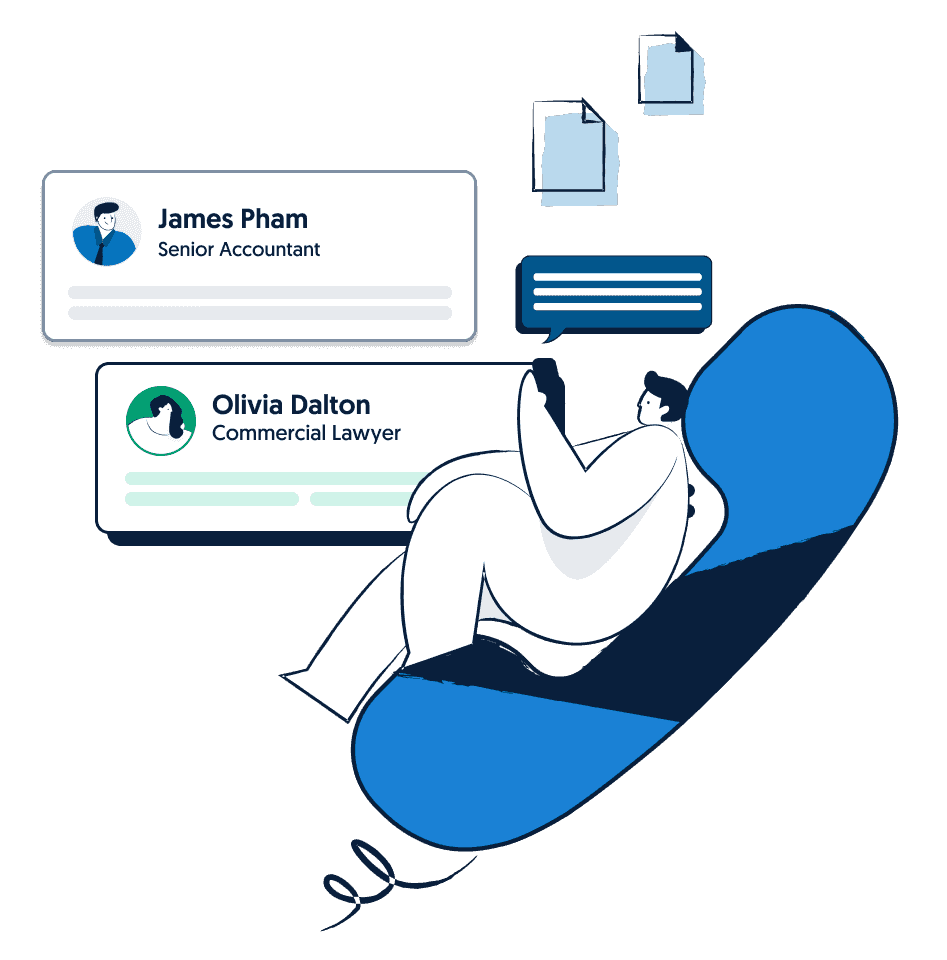Chartered Accountant Timothy Quinn leads Tax & Accounting at Lawpath. 16+ years in tax advisory, specialising in startup growth and expansion. Passionate about supporting entrepreneurial clients with early-stage investment incentives, restructuring, international exit strategy planning, and more.
As an Australian business owner, you might be wondering: How do I pay myself from my company? Whether you’re a sole trader, company director, or part of a partnership or trust, navigating your own financial stability can be difficult at first. Many business owners struggle to balance personal income with business growth.
In this article, we will guide you through the process of paying yourself as a business owner in Australia. We’ll cover different business structures and how these impact your pay, explore various payment methods, and offer practical guidance on tax and superannuation considerations.
Table of Contents
Understanding different business structures and how they impact your pay
The way you pay yourself as a business owner largely depends on the structure of your business. Each type of structure — sole trader, partnership, company (Pty Ltd), and trust — has unique implications for payment methods, taxation, and legal obligations.
Sole Traders
As a sole trader, you are not considered an employee of your business. Instead, any income your business earns is, in essence, your personal income. You must report any sole trader earnings on your individual tax return.
For example, if your business earns $80,000 in profit, this amount is added to any other personal income you earn and taxed at your individual income tax rate. As such, it is crucial that you set aside funds to meet your tax obligations during the tax season.

Need Financial or Legal Advice for your small business?
Registered Companies
If your business operates as a registered company, it is a separate legal entity. This means that you have two primary options to pay yourself as the business owner.
- Salary: You can draw a regular salary as an employee of your company. This ensures stable income but requires compliance with PAYG withholding tax and superannuation obligations.
- Dividends: You can also distribute profits as dividends to shareholders (including yourself). Dividends are subject to corporate tax rates (25% for small businesses) and may include franking credits to avoid double taxation.
Choosing between salary and dividends depends on factors like cash flow and tax efficiency. For instance, taking a modest salary ensures predictable income while leaving room for reinvestment in the business.
Partnerships
In partnerships, partners share the profits based on the partnership agreement. You and your partner will report your shares of the profit as personal income on your individual tax returns. For example, if you agree to split the profits equally and the partnership earns $100,000 in profit, you’ll each report $50,000 as income.
Trusts
Trusts distribute profits to beneficiaries according to the trust deed. If you are one of the beneficiaries, you’ll pay taxes based on your individual tax rate.
Trusts offer flexibility in managing income distribution but require careful planning to comply with legal requirements.
Different ways to pay yourself as a business owner
There are several ways to pay yourself as a business owner, and the best option depends on your business structure and financial goals. Each method has its own advantages, disadvantages, and tax implications, which are important to understand before making a decision.
Salary
A salary is a fixed payment that you make to yourself as the company’s employee. This option is ideal if you want consistent income and financial stability.
Salaries are subject to Pay As You Go (PAYG) withholding tax and superannuation obligations, meaning you must deduct taxes and contribute to your retirement savings.
The main advantage of taking a salary is the predictability it offers. However, it requires compliance with payroll regulations and incurs higher taxes than other methods. For example, if you take an annual salary of $60,000, taxes are withheld before you receive the net amount.
Owner’s Drawings
If you pay yourself as a sole trader or partner, you can use the owner’s drawings to withdraw profits from the business for personal use. This method is highly flexible because you can take money out as needed.
However, these withdrawals are taxed as part of your personal income, which means you must be disciplined about setting aside money for taxes.
The advantage of owner’s drawings is its simplicity — there’s no need to process payroll. That said, it requires careful record-keeping to ensure compliance with tax laws.
Dividends
Dividends are payments made to shareholders from a company’s profits. They are taxed at corporate rates first (25% or 30%, depending on the company’s size), but franking credits can reduce additional personal tax liabilities by offsetting taxes already paid by the company.
Dividends are attractive because you’ll generally pay tax later than on a salary. Neither do they require compulsory superannuation contributions. You may pay lower tax on dividends than salaries if you own your company through a Family Trust structure.
However, you can only pay yourself through dividends if the company has sufficient profits, so they are less reliable than a salary.
Distributions
Trust structures use distributions to allocate profits to beneficiaries according to the trust deed. You’ll pay tax on any profits distributed to you at your individual tax rate, which depends on your income level.
Trust distributions are very flexible and can be used strategically for tax planning. However, they require strict adherence to legal requirements outlined in the trust deed. They can also be more daunting in terms of administrative work compared to other payment methods.
How much should you pay yourself?
Besides choosing the payment method, you also need to decide how much to pay yourself. For this, you’ll have to find a balance between personal needs and business growth. Consider the following factors.
- Profits: Assess how much your business earns after expenses.
- Reinvestment needs: Leave enough funds in the business for operational costs and growth.
- Industry benchmarks: Compare salaries or drawings within your industry.
- Tax efficiency: Determine the tax rates you’ll incur with varying income levels.
For example, consultants might allocate 40% of profits to personal income, while retail store owners might take 20% due to higher operational costs.
Ultimately, how much you pay yourself will depend on a wide range of factors. If in doubt, it may be a good idea to consult with a professional accountant to make the right decisions.
Tax and superannuation considerations
Don’t forget that you’ll also need to think about taxes and superannuation when deciding how to pay yourself as a business owner. Here are your obligations by payment type:
- Salaries require PAYG withholding tax and super contributions.
- Owner’s drawings are taxed as part of personal income.
- Dividends are subject to corporate tax before being distributed.
- Distributions are taxed at beneficiaries’ individual rates.
Superannuation contributions are mandatory for employees (including company directors drawing a salary). Meanwhile, sole traders can make voluntary contributions for retirement savings.
For example:
- A sole trader earning $80,000 might contribute 10% ($8,000) voluntarily.
- A company director earning $60,000 must ensure super contributions are paid quarterly.
Each business’s situation is unique so your actual obligations and entitlements will depend on your specific circumstances.
Common mistakes to avoid when paying yourself
Here are some mistakes that business owners often make when it comes to paying themselves. We’ve also provided some tips to help you avoid these errors.
Underpaying or overpaying yourself
Taking too little from your business can leave you struggling to cover personal expenses, while taking too much may deplete your business’s cash flow.
Determine a reasonable and sustainable amount to pay yourself by assessing your business’s profitability, cash flow needs, and industry benchmarks.
Neglecting taxes
Failing to set aside funds for taxes can result in unexpected tax bills, penalties, and interest from the Australian Taxation Office (ATO).
Regularly calculate and set aside a portion of your income for taxes. Use accounting software or work with a tax professional to estimate your tax obligations accurately. Consider making quarterly tax payments to the ATO to avoid surprises at the end of the financial year.
Poor record-keeping
Inaccurate or incomplete financial records make it difficult to track income, expenses, and tax obligations. This can lead to errors in reporting income to the ATO and missed deductions.
Use reliable accounting software like MYOB to organise your financial records. Alternatively, hire a bookkeeper to ensure all transactions are recorded accurately and on time. Keep receipts, invoices, and bank statements for at least five years as required by Australian law.
Ignoring superannuation
Business owners who fail to make compulsory superannuation contributions risk facing fines and penalties from the ATO.
If you’re a sole trader, consider setting aside a portion of your income for voluntary super contributions to secure your retirement. If you’re a company director paying yourself a salary, ensure you meet the mandatory superannuation guarantee obligations by making quarterly contributions on time.
Overlooking legal obligations
Failing to comply with legal requirements such as PAYG withholding for salaries or correctly distributing profits in partnerships or trusts can lead to fines, audits, or disputes.
Familiarise yourself with the legal obligations tied to your business structure and make sure to comply with any of these regulations.
Want more?
Sign up for our newsletter and be the first to find hand-picked articles on topics that we believe are crucial to successfully scale your unique small business.
By clicking on 'Sign up to our newsletter' you are agreeing to the Lawpath Terms & Conditions
FAQs
How do I determine how much to pay myself?
Start by assessing your profit after expenses and comparing it with industry benchmarks. Leave enough for reinvestment while ensuring personal financial stability.
Can I pay myself as a contractor from my own business?
Yes, but only if you invoice the business for services rendered. This approach requires careful documentation and compliance with ATO rules.
Do I need to pay superannuation for myself?
If you’re a sole trader, super contributions are voluntary. Company directors drawing salaries must pay mandatory super contributions.
How do I report my income to the ATO?
Sole traders report earnings on their individual tax returns. Company directors report salaries separately from dividends or other payments.
What happens if my business isn’t making a profit?
If there’s no profit, you can only pay yourself a salary or owner’s drawings. Paying yourself as a business owner
Your next steps: Ensuring a sustainable income as a business owner
By understanding payment methods like salaries, owner’s drawings, dividends, or distributions — and staying compliant with tax laws — you can achieve both personal financial stability and long-term business success.
For tailored advice on structuring payments efficiently while ensuring business compliance, get in touch with Lawpath. We have a robust accounting and legal team to guide you every step of the way.
Don't know where to start?
Contact us on 1800 529 728 to learn more about customising legal documents, obtaining a fixed-fee quote from our network of 600+ expert lawyers or to get answers to your legal questions.







